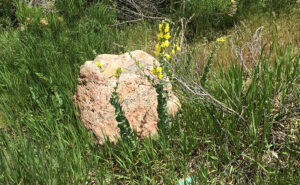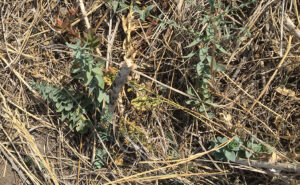Dalmatian toadflax
Broad-leaved Dalmatian Toadflax Linaria dalmatica
Narrow-leaved Dalmatian Toadflax Linaria genistifolia
Dalmatian toadflax is an herbaceous perennial found in rangeland, pastures, rights-of-way, and disturbed areas. An escaped ornamental, it was first brought to North America in the 18th century. Records show that it has been in Colorado since 1905
Plants grow to about 3 feet tall. Leaves grasp the stem and can be heart-shaped (Broad-leaved) or more narrow (narrow-leaved). Leaves reduce in size as they near the tip of the stems. Foliage and stems are grayish-green and have a waxy surface.
Plants flower between May-October. Flowers are snapdragon-shaped, pale to bright yellow with a spur.
Broad-leaved Dalmatian toadflax can produce up to 500,000 seeds per plant. Seeds may remain dormant for up to 10 years in the soil.
Broad-leaved Dalmatian toadflax has a deep taproot and lateral secondary roots that produce new plants from buds. Narrow-leaved toadflax has rhizomes. Both reproduce by seed and vegetatively.
Integrated management techniques include biological, chemical, and mechanical.
Dalmatian toadflax is known to hybridize with Yellow toadflax (Linaria vulgaris). The hybrid is fertile and shows varying characteristics of the parents.
RESOURCES





